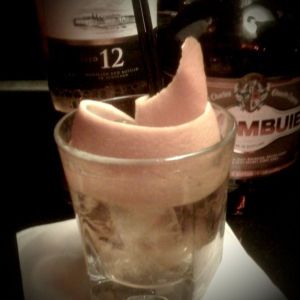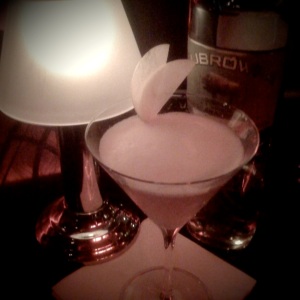Four: a Barbore Martini

There are a number of things I want to talk about.
- Angus Winchester has promised a bottle of Tanqueray No. Ten and a book from his extensive library of vintage and modern mixellany to the inventor of the drink named as the official Martini of Barbore. This is madness. I am, of course, totally there.
- Tea. A liking of tea is culturally hardwired into anyone who lives in the UK for more than six months. But there's way more to it than the bags of gunpowder routinely sweetened and enmilked in mugs across the land.
On the first, I really don't need a lot of encouragement to play around with Martini variations. I'm on the record saying that I think the Martini is a great drink but the current fashionable serve - vodka with next-to-no vermouth and no bitters - is hard work. So, honestly, the mere possibility of more cocktail reading and free gin (free gin!) is another carrot.
On the second, tea is really gaining some traction as an ingredient in mixed drinks. Any unbelievers should check out Charlotte Voisey's presentation on the theme from Tales of the Cocktail 2008. Different teas cover a wide spectrum from airy and floral to dark and pungent, and can be used to compliment a range of spirits and flavours.
There's a subtle coming together of themes on the way.

Basically, I wanted to use some white tea to compliment the camomile and citrus notes of Tanqueray No. Ten. To break it down to the most basic level, tea comes in three ways: black tea, where the leaves are left to fully oxidise; green tea, where the leaves are partially oxidised; and white tea, where the leaves are prevented from oxidising. According to Wikipedia - home of facts - the best examples of the highest grade white teas are said to be picked from undamaged and unopened buds in China's Fujian province between March 15 and April 10. When it's not raining. Curiously, white tea doesn't seem to be as popular worldwide as green, black tea or oolong. The next step was to find a way to infuse the tea flavour into the cocktail.
Rather than just adding x-ml of traditionally made white tea into a mixing glass, I decided to make a more concentrated infusion - soaking two bags in 150ml of vodka (I used Absolut, being the only plain vodka I had lying around) with a vanilla pod over a low heat for about three minutes. When I say low, I mean flames barely visible on the hob. The last thing you want to do with a spirit infusion is start another fractional distillation. With that done, I played things pretty traditionally. Being a martini for cocktail geeks, I've paid special attention to things like the starting temperature of ingredients and the specific amount of time they should be stirred for. Not because I particularly wanted to, but everyone else has...

A Barbore Martini
60ml Tanqueray No. Ten (at room temperature)
10ml Punt E Mes (from the fridge)
15ml White Tea infusion (from the fridge)
1 drop Angostura Aromatic Bitters
First, stick a small martini glass or a coupette in the freezer. Stir all the ingredients with ice in a standard mixing glass until it frosts over. Fine-strain into the chilled glass and snap a grapefruit zest twist over the top - don't drop it in!






